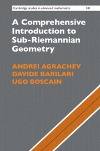- About MAA
- Membership
- MAA Publications
- Periodicals
- Blogs
- MAA Book Series
- MAA Press (an imprint of the AMS)
- MAA Notes
- MAA Reviews
- Mathematical Communication
- Information for Libraries
- Author Resources
- Advertise with MAA
- Meetings
- Competitions
- Programs
- Communities
- MAA Sections
- SIGMAA
- MAA Connect
- Students
- MAA Awards
- Awards Booklets
- Writing Awards
- Teaching Awards
- Service Awards
- Research Awards
- Lecture Awards
- Putnam Competition Individual and Team Winners
- D. E. Shaw Group AMC 8 Awards & Certificates
- Maryam Mirzakhani AMC 10 A Awards & Certificates
- Two Sigma AMC 10 B Awards & Certificates
- Jane Street AMC 12 A Awards & Certificates
- Akamai AMC 12 B Awards & Certificates
- High School Teachers
- News
You are here
A Comprehensive Introduction to Sub-Riemannian Geometry

Publisher:
Cambridge University Press
Publication Date:
2019
Number of Pages:
762
Format:
Hardcover
Series:
Cambridge Studies in Advanced Mathematics
Price:
190.00
ISBN:
9781108476355
Category:
Monograph
[Reviewed by , on ]
Robert Neel
02/27/2021
This book treats a wide variety of topics in sub-Riemannian geometry, as the “comprehensive” in the title suggests and a look at the table of contents confirms. Briefly, sub-Riemannian geometry can be viewed as a generalization of Riemannian geometry in which one can travel only along a subspace of the tangent space, but nonetheless every point is reachable from every other. Several situations motivate sub-Riemannian geometry, including hypoelliptic diffusions, the calculus of variations, and complex analysis. The present book focuses on geodesic geometry, which has a natural connection to optimal control, and which means that the sub-Riemannian distance and the corresponding length-minimizing curves are central objects of study.
The first part of the book provides the basic definitions of sub-Riemannian manifolds, admissible curves, and the corresponding distance and proves the foundational results on the finiteness and continuity of the distance and the existence of length-minimizing curves. It also introduces the notions of normal and abnormal extremals and the Hamiltonian formalism that is used to study them. Normal and abnormal extremals are the two classes of curves that satisfy necessary first-order conditions to be length minimizers. The second, and longest, part of the book is devoted to a detailed study of both normal and abnormal minimizers and associated objects like the exponential map, the cut and conjugate loci, and the smoothness properties of the distance function. One takeaway is that away from abnormal minimizers, the geodesic structure is analogous to that of a Riemannian manifold, while abnormal minimizers represent a truly sub-Riemannian phenomenon and are much more difficult to understand. The third part of the book is centered around the notion of curvature. The question of how to define curvature and curvature bounds on sub-Riemannian manifolds has been an active topic in recent years. The approach developed in this book is based on variations of geodesics and the corresponding generalization of Jacobi fields to Jacobi curves. Finally, the last couple of chapters briefly address some related topics outside of the main thrust of the book, such as the choice of a volume on a sub-Riemannian manifold and the sub-Riemannian heat equation.
One welcome feature of the book is that the authors can often give a general account of some aspect of sub-Riemannian geometry and then also give a largely-independent treatment of the most important or elementary particular case. While almost every book illustrates the general theory with examples to some extent, the present authors seem especially committed to this approach. For example, from the beginning, the authors work with the most general definition of a sub-Riemannian manifold in terms of bundle maps; in particular, this accommodates the rank-varying case. Chapter 9 complements this by giving an essentially self-contained treatment of 2-dimensional almost-Riemannian manifolds, which are the simplest special case of rank-varying sub-Riemannian structures. Similarly, the treatment of normal geodesics in the first several chapters is illustrated with a substantial Chapter 7 on more explicit computation of normal geodesics on left-invariant structures on Lie groups, while the rather technical general discussion of sub-Riemannian curvature in terms of Jacobi curves in Chapters 14 and 15 is followed by the translation into the classical Riemannian context in Chapter 16 and the specialization to three-dimensional contact sub-Riemannian structures in Chapter 17.
The formal prerequisites are kept to a minimum; elementary real analysis, integration theory and, starting in Chapter 6, some basic functional analysis are all that is needed. In particular, background in Riemannian geometry is not assumed, and in principle, a first course in Riemannian geometry, emphasizing geodesic geometry from the Hamiltonian point of view, can be extracted from the book. That said, much of the development of sub-Riemannian geometry is motivated by comparison to Riemannian geometry, so previous knowledge of Riemannian geometry will make the book easier to follow. At a smaller scale, sub-Riemannian geometry touches on many other areas, such as Lie groups, and previous experience in any of these topics will be helpful.
The book can be used for either an introductory or advanced course on sub-Riemannian geometry (the authors suggest which chapters to use for each case), but it also constitutes a state-of-the-art reference for most of the topics that it treats and will be an essential work for researchers active in sub-Riemannian geometry. There are exercises included throughout the text, though their density varies somewhat from topic to topic. Bibliographic notes at the end of each chapter, complemented by the substantial bibliography, gives both historical background as well as suggestions for further reading.
Robert Neel (robert.neel@lehigh.edu) is an associate professor in the Department of Mathematics at Lehigh University. His research interests are centered around stochastic analysis on manifolds.
See the publisher's website.
- Log in to post comments




